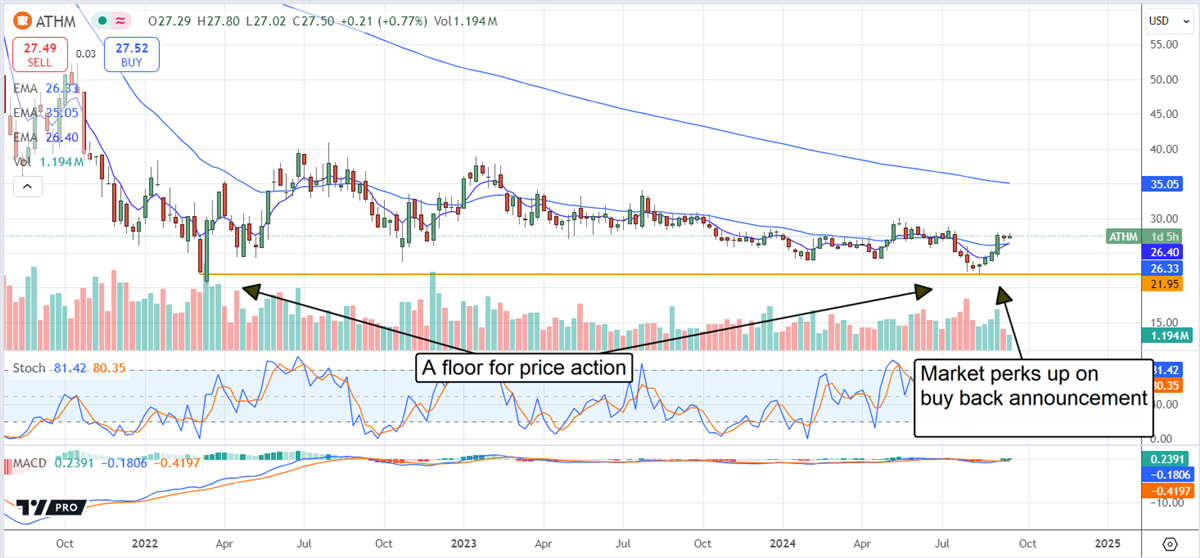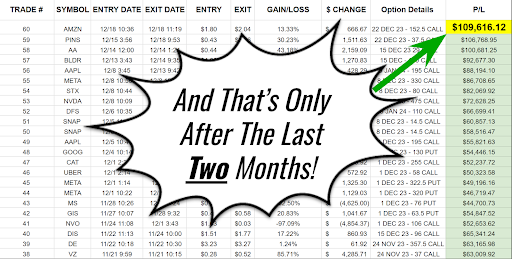Ticker Reports for September 21st
Triple Witching: The Market's Quarterly Rollercoaster
The stock market is an active ecosystem constantly influenced by various factors. One such factor, occurring four times a year, is the “triple witching.” This event, which takes place on the third Friday of March, June, September, and December, can significantly impact market volatility and present unique trading opportunities.
A Historical Perspective
Triple witching has been a recurring event in the financial markets since the 1980s, with its origins tied to the introduction of stock index futures and options contracts. Triple witching days have historically been associated with increased market volatility and significant price movements. While the exact impact can vary from year to year, triple witching days have consistently contributed to heightened trading activity and market turbulence.
The Triple Witching Formula: Three Derivatives, One Powerful Event
The simultaneous expiration of three distinct types of derivatives – stock options, stock index futures, and stock index options – is known as triple witching. This event occurs four times a year, on the third Friday of March, June, September, and December, and can significantly impact market activity.
The Triple Witching Formula
- Stock Options: These grant the holder the right, but not the obligation, to buy or sell a specific stock at a predetermined price (the strike price) by a specific date (the expiration date). Options provide investors with the flexibility to profit from price movements without actually owning the underlying stock.
- Stock Index Futures: These obligate the buyer to purchase, or the seller to sell, a specific stock index (like the S&P 500) at a set price on a future date. Index futures allow investors to speculate on the market's overall direction or hedge against potential market risks.
- Stock Index Options: Similar to stock options, these grant the holder the right, but not the obligation, to buy or sell a specific stock index at a predetermined price by a certain date. Index options offer flexibility to capitalize on anticipated movements in the underlying index without having to own the index itself.
A surge in market activity, known as triple witching, occurs on the day the stock, index, and options contracts expire simultaneously. This surge results from traders rushing to manage their positions before the contracts' expiration. This heightened trading activity significantly impacts market volatility, creating opportunities and potential risks for traders. Understanding the dynamics of triple witching is essential for investors, regardless of their experience level. By grasping the unique characteristics of this event, investors can make informed decisions about their trading strategies and portfolio management.
Triple Witching: A Surge in Trading Activity
The simultaneous expiration of stock options, index futures, and index options creates a surge in trading activity, known as triple witching. This surge occurs as traders rush to manage their expiring positions before the deadline. For many investors, especially those new to the market, understanding these actions is essential to grasp the impact of triple witching on market volatility.
Traders typically take one of three actions:
- Closing out positions: They may choose to buy or sell the underlying asset to offset their existing contracts. For example, a trader holding a stock option contract to buy a stock at a specific price may decide to sell it at the current market price to eliminate their position. This helps them avoid potential losses or lock in potential profits.
- Rolling over positions: Traders may replace expiring contracts with new ones with a later expiration date. This allows them to maintain their exposure to the market while adjusting their strategy based on changing market conditions.
- Exercising options: If options are “in-the-money” (profitable), the holder may choose to exercise them, buying or selling the underlying asset at the strike price. This can lead to significant trading activity in the underlying asset, further contributing to market volatility.
This flurry of activity creates a high-pressure environment that can impact liquidity and create opportunities for risk and reward. Active traders often try to capitalize on these opportunities, but it's crucial to remember that volatility can lead to losses.
Triple Witching in the Current Market Context
The upcoming triple witching event is pivotal as investors grapple with shifting economic tides. The Federal Reserve's recent interest rate cuts, intended to jumpstart growth, have already injected a dose of volatility into the market. The VIX, a widely watched gauge of expected market swings, remains elevated, signaling a heightened level of investor caution. The triple witching further amplifies this cautious sentiment.
It coincides with the S&P 500 rebalancing, which typically triggers significant trading activity as funds adjust their holdings to reflect the new index composition.
This confluence of factors creates a complex market environment ripe for volatility. The upcoming triple witching event will likely be exacerbated by these pre-existing market tensions, making careful observation and strategic planning critical for investors of all levels.
Triple Witching: A Double-Edged Sword for Active Traders
While long-term investors may simply weather the storm of triple witching, for active traders, the event represents a double-edged sword. It's a time of heightened opportunity but also increased risk. The surge in trading activity, caused by the simultaneous expiration of options, index futures, and index options, creates a volatile market ripe for gains and losses.
For those with the experience and risk appetite, triple witching presents unique opportunities. The increased volume and potential for price discrepancies can create situations where savvy traders can exploit arbitrage opportunities. They might capitalize on temporary price differences across different markets, buying low and selling high, to profit from market inefficiencies. This heightened activity can also allow traders to enter and exit positions more quickly, capitalizing on short-term market swings.
However, this volatility can also be a trader's worst enemy. Active traders need to be acutely aware of the risks involved. The unpredictable nature of triple witching demands meticulous risk management strategies to mitigate potential losses. This is particularly important as the increased trading volume can sometimes lead to less liquid markets for specific securities, especially in sectors with lower trading volume, such as energy or utilities. This decreased liquidity can widen the bid-ask spread, making it harder to execute trades efficiently and potentially leading to higher transaction costs.
Traders looking to capitalize on triple witching must consider a variety of factors. Options strategies can be employed to profit from anticipated price movements, while hedging techniques can help mitigate risk during periods of heightened volatility. However, it's crucial to remember that these strategies can be complex and require a thorough understanding of market dynamics and risk management principles.
Key Takeaway: While triple witching presents opportunities for active traders to capitalize on market volatility, it is essential to approach this event with caution and a well-defined risk management strategy. It's a game of heightened stakes, where informed decisions and careful execution are paramount.
Balancing Opportunity and Risk in a Volatile Market
Triple witching, a quarterly phenomenon that shakes up the market, is a unique event that requires careful consideration. Long-term investors may simply ride out the storm, understanding that the volatility is typically short-lived. However, active traders must approach this period with a keen eye for opportunities and a solid understanding of risk management principles. As with all aspects of the stock market, informed decision-making based on a thorough understanding of the market's intricacies is critical to navigate this volatile period successfully.
How a $0.25 cent option contract makes my top traders feel
If you don't know me, I've been in the markets for over 40 years… but recently, I've discovered a breakthrough that might be my favorite strategy of ALL time!
While I kept the finer details of these $0.25 Cent Trades under wraps until recently…
4 Stocks Set to Benefit from Recent Interest Rate Cuts
The stock market is about to make a major shift, this time driven by the shift in monetary policy set on by the Federal Reserve (the Fed). After the most recent meeting to decide the new path of interest rates for the United States, Jerome Powell (the Fed chairman) cut interest rates by the most aggressive pace in 16 years.
That means a few things for the stock market, but investors must understand that not all industries will be affected equally. The ones that deserve a second – or deeper – look are those that depend on consumer and financial trends, sectors like consumer discretionary and real estate. There’s even a historical tendency for oil prices to do well on lower interest rates. Hence, the energy sector deserves a spot on this list as well.
Within these spaces, names like Nike Inc. (NYSE: NKE), Chesapeake Energy Co. (NASDAQ: CHK), and even SoFi Technologies Inc. (NASDAQ: SOFI) carry enough reasons to potentially become relative winners in the coming quarters, especially as money and investors begin to shift their preferences to match this new business cycle.
Consumer Stocks Like Nike Poised for a Comeback with Rate Cuts on the Horizon
Nike shares have been volatile recently, particularly after the company reported a less-than-spectacular quarter. Leaning on China slowdowns and weakening U.S. consumer sentiment, bears raided Nike stock after the results came out.
However, some on Wall Street saw far ahead enough to pick up this stock at its lows, such as billionaire hedge fund manager Bill Ackman. More than that, analysts at Sanford C. Bernstein see the stock as worth up to $109 a share, calling for up to 32.4% upside from where it trades today.
Reacting to the recent Wall Street bullishness and institutional buying, bears retreated from further selling this stock, as Nike stock’s short interest declined by 14.5% in the past month alone. The stock still trades at only 67% of its 52-week high, leaving enough room for investors to catch a further recovery rally.
Energy Stocks Are Strong, But Chesapeake Stock Stands Out as the Better Pick
Over the past month, shares of Chesapeake have gone on a bit of a tear, rallying by as much as 7.5% as front-run expectations for Fed interest rate cuts started to influence the energy sector positively. One big investor who saw this trend coming is Warren Buffett.
Based on this belief, Buffett bought up to 29% of Occidental Petroleum Co. (NYSE: OXY), but retail investors have an advantage over mega investors like Buffett. They can choose smaller companies, especially those placed higher in the industry’s value chain and paid first.
Chesapeake Energy stock is one example, and Wall Street knows this. Those at Stephens see a potential bull case in which this stock reaches a valuation of $118 a share, daring it to rally by as much as 53.6% from where it trades today. Considering Chesapeake is still only 83% of its 52-week high, investors have a new reason to call for new highs.
That reason is interest rate cuts, which typically help boost business activity and demand, which rely on oil for manufacturing and transport. As oil prices recover based on these trends, Chesapeake stock might be at the center of the bullish price action, given its place in the value chain for exploration and production.
Lower Mortgage Rates Could Propel SoFi Stock to New Heights
Many would-be home buyers are sitting on the sidelines, waiting for more affordable financing rates through more accessible mortgages. Investors should remember that when interest rates come down, so do mortgage rates, enabling new home buyers to enter the market.
This is where SoFi stock comes into play and why Wall Street holds it in such high regard. Now that the stock is down to 80% of its 52-week high, there are a few more tailwinds in place to let investors assume this name could make its way back and even make a new high.
Wall Street analysts forecast up to $0.07 in earnings per share (EPS) in SoFi stock for the next 12 months, up from today’s EPS of $0.01. This is a seven-fold jump in profits, meaning some of the current price targets and valuations might have to be adjusted upward in face of this potential spike.
Those at Dimensional Fund Advisors saw enough reason to boost their holdings in SoFi stock by up to 263.3% as of August 2024, bringing their net investment to $86.5 million today, or 1.2% ownership in the company.
Wall Street’s Latest Top Pick Comes from a Different Market
Stanley Druckenmiller (responsible for George Soros’ returns) decided to sell out of the U.S. technology sector and sought to relocate his winnings into the bond market. Remember how mortgage rates come down during Fed cuts? So do bond yields.
Just like any other fixed-income product, prices are inversely related to yield, so as bond yields come down, their prices will go up. Investors can copy Druckenmiller’s playbook and check out the iShares 20+ Year Bond ETF (NASDAQ: TLT) for potential exposure.
The ETF has recently declined by roughly 3% from its highs. However, momentum is still bullish enough to suggest further upside from this level, especially as the Fed might keep cutting rates for the next 12 months, bringing the price of bonds higher and higher.
This P/L chart will make your eyes pop
Today I want to show you how our research shows you could've grown a $25,000 account into $109,616.12 within the last TWO months.
You see, former multi-million dollar hedge fund manager Roger Scott spent the better half of 2023 developing what might be the most advanced trading tool that exists…
It's a revolutionary software system that tracks the moves of institutional investors…. in real time…
Autohome's Dividend and Buyback Make It a Strong EV Play
Autohome (NYSE: ATHM) is an interesting play on China’s EV market that comes without OEM risk. The OEMs are selling cars, but profitability is elusive, and competition is fierce, factors that will continue to influence their price action for the foreseeable future. Autohome, on the other hand, operates platforms connecting the automobile industry to consumers.
Autohome websites and apps provide advertising, lead generation, listing, transaction, and insurance services and are tied to the volume of China’s business and not any individual OEM. The salient details are that it makes money today, has a healthy and improving cash flow, and offers an attractive capital return, which makes it more of an investment and less of a trade.
China’s automobile market estimates are mixed, but expect low-to-mid-single-digit growth this year and next, led by EVs. EV sales are expected to grow by 15% to 20% over the next few years and slowly dominate the existing market. Numerous factors will influence growth, including the recent release of BYD’s (OTCMKTS: BYDDF) low-priced Seagull model. At roughly $12,000, it is half the cost of existing low-priced options.
Autohome's Growth Is Slow in 2024: Operational Quality Shines
Autohome’s growth is slow in 2024, sustaining a low-single-digit pace in Q2, but growth is present and expected to improve sequentially and next year. Revenue was driven by increasing user counts offset by sluggish demand impacted by economic headwinds. The critical details include the margin and cash flow, which have improved due to operational quality. Net income grew nearly 3% versus the almost 1% gain in revenue, driving an increase in earnings. The adjusted earnings are up nearly 1000 basis points and are expected to remain solid as the quarter's progress.
Cash flow is another critical detail. Cash flow is positive despite the company’s lean toward technology and marketing, allowing it to sustain a fortress balance sheet and initiate a buyback program. The buyback program is worth $200 million and is expected to be completed within twelve months. The allotment is worth nearly 6% of the market cap, with shares trading near $27.50, and will provide a significant tailwind for the market.
Autohome’s capital return also includes a substantial dividend. The dividend payment is worth about 6% annually to investors and is expected to be paid in two semi-annual payments through 2026. The payment is roughly 65% of quarterly earnings, a high figure offset by the clean balance sheet. The company has no long-term debt and runs a total liability-to-equity ratio of 0.2x.
Institutions Provide a Tailwind for Autohome Stock
Analyst coverage of Autohome is tepid, but institutional interest isn’t. Institutions have bought this stock on balance for three consecutive quarters and own nearly 65% of it. Major shareholders include Ping An Insurance Group, an online insurance destination in China, which holds about 45% of the stock.
The price action in Autohome stock has struggled for years but shows a clear bottom at $22. The market is moving up from that level, supported by the recent earnings report and subsequent repurchase announcement, and is likely to head higher in the near term. There is some resistance at the $27.50 level, but it will not likely last, given the size of the buyback announcement, strength of cash flow, balance sheet, growth outlook, and dividend. The next target for substantial resistance is near $32 or about 15% of upside.







0 Response to "🌟 4 Stocks Set to Benefit from Recent Interest Rate Cuts"
Post a Comment